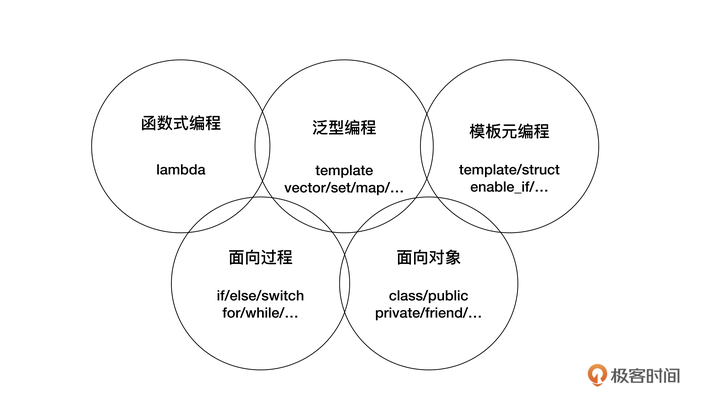元编程 (meta-programming)
meta:英语前缀词根,来源于希腊文。中国大陆一般翻译成”元“。
在逻辑学中,可以理解为:关于X的更高层次,同时,这个更高层次的范围仍然在X的范围之内。
meta-data
meta-function
meta-bank
meta-verse
meta-programming
诞生必然性:需要非常灵活的代码来适应快速变化的需求,同时保证性能。
元编程 (meta-programming) 通过操作 程序实体 (program entity),在 编译时 (compile time) 计算出 运行时 (runtime) 需要的常数、类型、代码的方法。
区别:
一般代码的操作对象是数据。
元编程的操作对象是代码。code as data。
如果编程的本质是抽象,那么元编程就是更高层次的抽象。
Metaprogramming is writing code that writes code.
数值计算和类型计算。
计算机语言有两种类型:
Lisp是第一个实现了“将代码作为数据”的语言。
元编程机制是现代编程语言的标配。
C++:Boost MPL、Facebook fatal(Facebook Template Library)、Blitz++。
Julia:天生自带。
C++是一个语言联邦,集众家之所长。C++之父表示“我只是熟悉”。
其中,”模板元“是最难的,有些代码像看天书。
随着C++20版本的发布,按照后续发展趋势,这些范式会融为一体,彼此没有非常明确的界限,混合范式是将来的趋势。

“面向过程”和“面向对象”是最基本的范式,是C++的基础,无论如何都是必须要掌握的。
如果是开发直接面对用户的普通应用(Application),那么可以再研究一下“泛型”和“函数式”。
如果是开发面向程序员的库(Library),那么非常有必要深入了解“泛型”和“模板元”,优化库的接口和运行效率。
最开始,模板技术是为了实现泛型的,是泛型编程的基础。
后来,偶然发现模板可以用来实现元编程机制,并且证明了模板技术是图灵完备的。
于是模板元编程(template meta-programming,TMP)就诞生了。
模板能做元编程完全是个意外,所以其语法其丑无比。
模板语法很丑,但是它很强大。
C++以模板为基础,历经多个版本,把元编程这个坑越挖越大,也越来越漂亮。
Q:如果模板不能实现元编程机制,C++中的元编程机制会如何实现?
A:如果模板不能实现元编程机制,C++也会通过其他方式来实现元编程机制。原因:高性能是C++不可能放弃的方向。
基本的程序结构:顺序、选择、循环。
顺序结构:按照语句出现的先后顺序一次执行
选择结构:根据条件判断是否执行相关语句
循环结构:当条件成立时,重复执行某些语句
图灵完备。理论上可以实现任何可实现的算法。
模板元编程使用C++中的静态语言成分,所以不能操作变量,只能操作类型和常量。
命名约定:类型_Ty、常量_Val。
非强制约定。
命名约定:类型type、常量value。也有用_t、_v封装。
强制约定。
template< class T >using remove_reference_t = typename remove_reference<T>::type;template< class T >inline constexpr bool is_class_v = is_class<T>::value;还有一种输出:代码。一般指代码展开。
元编程是以模板为基础,准确的说应该是模板特化和递归。



C++11之前用递归的模板实例化来实现,比较复杂。
template<unsigned int n>struct Factorial { enum { value = n * factory<n - 1>::value };};template<>struct Factorial<0> { enum { value = 1 };};int main() { Factorial<4>::value; return 0;}C++11引入了constexpr, 另一种实现。
template<unsigned int n>struct Factorial { static constexpr int value = n * Factorial<n - 1>::value ;};template<>struct Factorial<0> { static constexpr int value = 1;};int main() { Factorial<4>::value; return 0;}C++14完善了constexpr,大大简化了这个实现。
template <typename T>constexpr T Factorial(T x) { if (x <= 1) { return 1; } T s = 1; for (T i = 2; i <= x; i++) { s *= i; } return s;}int main() { static_assert(Factorial(4) == 24, "error"); return 0;}递归实现
constexpr int Factorial(unsigned int n) { if (n <= 1) { return 1; } else { return n * Factorial(n - 1); }}int main() { static_assert(Factorial(4) == 24, "error"); return 0;}constexpr :表示修饰的对象可以在编译期算出来,修饰的对象可以当做常量。
修饰变量:
这个变量就是编译期常量。
修饰函数:
如果传入的参数可以在编译时期计算出来,那么这个函数就会产生编译时期的值。
否则,这个函数就和普通函数一样了。
修饰构造函数:
这个构造函数只能用初始化列表给属性赋值并且函数体要是空的。
构造函数创建的对象可以当作常量使用。
constexpr的特点:
Q:const和constexpr的区别?
A:在 C 里面,const 很明确只有「只读 read only」一个语义,不会混淆。C++ 在此基础上增加了「常量 const」语义,也由 const 关键字来承担,引出来一些奇怪的问题。C++11 把「常量」语义拆出来,交给新引入的 constexpr 关键字。
在 C++11 以后,建议凡是「常量」语义的场景都使用 constexpr,只对「只读」语义使用 const。
constexpr简化了值元编程的难度,但是应用范围有限。constexpr的初衷是为了承担「常量」语义。
template <class _Ty>struct remove_reference { using type = _Ty;};template <class _Ty>struct remove_reference<_Ty&> { using type = _Ty;};template <class _Ty>struct remove_reference<_Ty&&> { using type = _Ty;};template <class _Ty>using remove_reference_t = typename remove_reference<_Ty>::type;//以下写法等价int a;remove_reference_t<int> a;remove_reference_t<int&> a;remove_reference_t<int&&> a;计算array的点积。
#include <iostream>#include <array>using namespace std;template<typename T, std::size_t N>struct DotProductT { static inline T result(const T* a, const T* b) { return (*a) * (*b) + DotProductT<T, N - 1>::result(a + 1, b + 1); }};template<typename T>struct DotProductT<T, 0> { static inline T result(const T*, const T*) { return T{}; }};template<typename T, std::size_t N>auto dotProduct(std::array<T, N> const& x, std::array<T, N> const& y) { return DotProductT<T, N>::result(x.data(), y.data());}int main() { array<int, 3> A{1, 2, 3}; auto x = dotProduct(A, A); cout << x << endl; return 0;}编译时:生成了代码结构,把for循环展开。
运行时:执行生成的代码,计算出结果。
为了统一,返回值的命名为“value”,返回类型的命名为“type”。
实践证明,对于现代C++编程而言,元编程最大的用场并不在于编译期数值计算,而是用于类型计算(type computation)。
类型计算分为两类:
template< class T >using remove_reference_t = typename remove_reference<T>::type;template< class T >inline constexpr bool is_class_v = is_class<T>::value;进一步统一,返回“value”的都改为返回“type”,通过一个类模板封装:
修改前:
template <typename T> struct is_reference { static constexpr bool value = false; }; template <typename T> struct is_reference<T&> { static constexpr bool value = true; }; template <typename T> struct is_reference<T&&> { static constexpr bool value = true; };修改后:
template <bool b>struct bool_ { static constexpr bool value = b; };template <typename T> struct is_reference { using type = bool_<false>; };template <typename T> struct is_reference<T&> { using type = bool_<true>; };template <typename T> struct is_reference<T&&> { using type = bool_<true>; };在调用 is_reference 时,也是使用 “type” 这个名字,如果想访问结果中的布尔值,使用 is_reference<T>::type::value 即可。
保证外界在使用类型计算时,都以 “type” 作为唯一的返回值。
目的是规范元编程的代码,使其更具可读性和兼容性。
C++11 引入了关键字static_assert。
static_assert(1 + 1 == 2, "error");C++20 concept、requires
#include <iostream>#include <type_traits>using namespace std;template<typename T>concept Integral = is_integral_v<T>;template<Integral T>T Add(T a, T b) { return a + b;}template<typename T> requires Integral<T>T Add2(T a, T b) { return a + b;}template<typename T>T Add3(T a, T b) requires Integral<T> { return a + b;}Integral auto Add4(Integral auto a, Integral auto b) { return a + b;}int main() { Add(1, 2); //Add(1.1, 2.2); //error “Add”: 未满足关联约束 return 0;}还支持不同参数设置不同的约束。
template<typename T>concept Floating = ::is_floating_point_v<T>;auto Add5(Integral auto a, Floating auto b) { return a + b;}template<typename T1, typename T2> requires Integral<T1> && Floating<T2>double Add6(T1 a, T2 b) { return a + b;}concept替代了C++11的enable_if。
concept可以使代码清晰不少,还可以使编译错误提示更直观。
C++20的四大特性:concept、ranges、coroutine、module
concept 语法的出现,大大简化了泛型编程和元编程的难度。
类型参数、模板参数、typedef/using、enum/static/constexpr、内嵌类成员
SFINAE(Substitution Failure Is Not An Error):替换失败不是一个错误。
C++11 enable_if、conditional
C++20 concept、requires
介绍下<type_traits>基础类,integral_constant包装了指定类型的静态常量。
template <class _Ty, _Ty _Val>struct integral_constant { static constexpr _Ty value = _Val; using value_type = _Ty; using type = integral_constant; constexpr operator value_type() const noexcept { return value; } // since c++14 _NODISCARD constexpr value_type operator()() const noexcept { return value; }};template <bool _Val>using bool_constant = integral_constant<bool, _Val>;using true_type = bool_constant<true>;using false_type = bool_constant<false>;JuMP ("Julia for Mathematical Programming")
using JuMPusing GLPKmodel = Model(GLPK.Optimizer)@variable(model, x >= 0)@variable(model, 0 <= y <= 3)@objective(model, Max, 12x + 20y)@constraint(model, c1, 6x + 8y <= 100)@constraint(model, c2, 7x + 12y <= 120)print(model)optimize!(model)@show termination_status(model)@show primal_status(model)@show dual_status(model)@show objective_value(model)@show value(x)@show value(y)@show shadow_price(c1)@show shadow_price(c2)输出:
julia> Max 12 x + 20 ySubject to c1 : 6 x + 8 y <= 100.0 c2 : 7 x + 12 y <= 120.0 x >= 0.0 y >= 0.0 y <= 3.0termination_status(model) = MathOptInterface.OPTIMALprimal_status(model) = MathOptInterface.FEASIBLE_POINTdual_status(model) = MathOptInterface.FEASIBLE_POINTobjective_value(model) = 204.99999999999997value(x) = 15.000000000000005value(y) = 1.249999999999996shadow_price(c1) = 0.24999999999999922shadow_price(c2) = 1.5000000000000007可以看下这个https://www.youtube.com/watch?v=SeqAQHKLNj4
多重派发技术可以实现元编程机制。图灵完备。
C++模板的加强版,Julia的语法写起来更优雅。
dispatch:根据参数的类型,选择同名函数的不同实现
static dispatch表示根据编译时类型选择
dynamic dispatch根据运行时类型选择
single dispatch表示根据函数第一个参数的类型选择
multiple dispatch表示根据函数所有参数类型选择
C++: multiple static dispatch + single dynamic dispatch
Julia: multiple dynamic dispatch
https://zhuanlan.zhihu.com/p/138875601
https://zhuanlan.zhihu.com/p/378356824
https://max.book118.com/html/2017/0713/122000037.shtm
https://zhuanlan.zhihu.com/p/266086040
https://www.youtube.com/watch?v=SeqAQHKLNj4
https://zhuanlan.zhihu.com/p/105953560